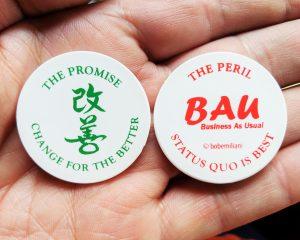
A hallmark of classical management, rooted in batch-and-queue material and information processing, is the existence of a perpetual state of confusion. That is not a good state to be in. People cannot think clearly when they are confused, and so when confronted with problems they rely on long-established habits and reflexes for their response. This is what we see from managers at all levels, from supervisor to CEO. They have automatic or habitual responses to both problems and opportunities. I’d like to focus here on reflexive responses to problems, which often border on instinctive reactions.
For example, when something goes wrong in classical management, the habitual managerial response is to blame someone for the problem. If a person proactively points out problems time and again, the habitual managerial response is to treat such persons as outcasts. In these two common examples, bosses do not think, they react. It is a no-thinking reflex that they have seen others do, so they do it too, and the reflex comes to be seen as natural, right, and proper. Not thinking is not natural, right, or proper.
Manager’s habits are acquired through social learning, not reasoning. Managers learn from other managers. You see the same phenomenon in kaizen when you ask someone “Why do you do it that way?” Their answer is “I don’t know” or “We have always done it that way.” So the way people do things at work is usually not the result of reasoning — critical thinking and problem-solving. Tradition is not subjected to critical thinking and problem-solving. When one does that, they are either forced to conform to tradition or they are made to suffer socially (or worse). This, among other things, makes business inherently conservative and thus unwilling to change. The replication of managers habits and reflexes from one generation to the next assure that everyone suffers.
Habits are the default problem-solving method, and these habits become difficult to replace with better problem-solving methods — the ones that illuminate cause-and-effect and expose the root cause. If, by chance, traditional habits are replaced by better problem-solving methods, they quickly become diluted, purposefully or not, such that they support pre-existing habits and traditions. Under these circumstances, organizations will never come close to achieving the important goal of Lean transformation.
Yet, one’s reputation as a leader is usually established by being good at applying old habits and traditions. So when business problems arise, that’s what managers rely on. One such old habit is emulation — keeping up with the Joneses. “Doing Lean” is emulation; it raises the status of the company and its leaders regardless of actual accomplishments — for example, no culture change, no material and information flow, no Just-in-Time. Joining the Lean bandwagon is reputable; a mark of competent leadership for which one can take and get credit for.
Business logic says that if the critical thinking and problem-solving methods that expose root causes do not produce a money value, then it is no good — and certainly no better than the traditional management habits and reflexes used to solve problems. Furthermore, if property is insecure, as it is in the United States where businesses are subject to leveraged buyouts, mergers, etc., then business logic says that it does not make sense to invest much time, labor, and money for gains that one may never see or which may fall into the hands of rivals. Hence, “doing Lean,” emulating other organizations, is good enough. Lean transformation is unnecessary and excessive. Perpetual confusion (waste) is symbiotic with the status quo, business as usual, and long-established habits and reflexes, and is therefore desirable.
Business logic dictates how Lean management is used. There has never been any restriction on how executives should understand and use Lean management. As a result, Lean was incorporated within the existing framework of business logic, habits of thought, and traditions. There have been some exceptions, but these are rare because few leaders volunteer to make the transition from habits and reflexes to reasoning. In doing so, they made the transition from perpetual confusion to calmness and order. But to do that, they had to upset the status quo, abandon business as usual, and aggressively pursue “change for the better.”
Think of these words in relation to business and the workplace:
“Virtually all thoughtful persons… will agree that it is a despicably inhuman thing for the current generation willfully to make the way of life harder for the next generation…” Thorstein Veblen, 1914
BAU (Business as Usual) makes life harder for the next generation. That’s what classical management has done.
